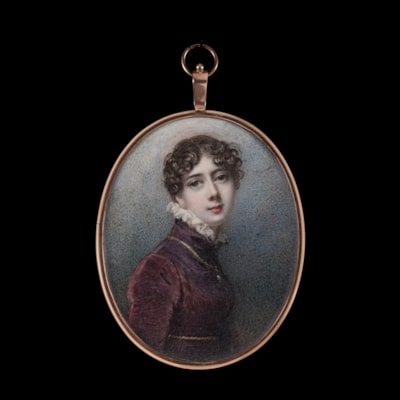ENGLISH SCHOOL (19th century)
Eight eye miniatures with blue and hazel eyes; circa 1800-1820
Circa 1800-1820
Set into a tortoiseshell box
Each eye 20mm (0.75 in) diam.; box 90 x 70 x 25 mm
SOLD
This extraordinary set of eight eyes would appear to be a rarity in the number of commissioned works in a single setting. Eye miniatures, also coined ‘lover’s eyes’ are usually singular, likely owing to their intimate nature. When George, Prince of Wales, sent Maria Fitzherbert his eye miniature (he wrote ‘I send you a Parcel. . . and I send you at the same time an Eye, if you have not totally forgotten the whole countenance. I think the likeness will strike you’, he began a fad for eye miniatures which quickly caught on in his circle of friends.[1]
Although seemingly modest, this group of eyes begs the question of the link between the possessor of each eye. The eyes belong to a largely ungendered group (from the glimpse of hair given in each, it is not possible to determine whether we are looking at men, women or a mix of the two) who would appear to be of similar age. Differences in eye and hair colour suggest that the sitters are not related and therefore we may be looking at a group of friends. Only one other example is known of five eyes, lips and noses, painted together with a cloud background [Private Collection] in what is clearly an erotically charged amalgamation of facial details.
As with so many eye miniatures, both the artist’s and sitter’s identity are now lost, There is simply not enough painted information to reveal either. By the time eye miniatures became popular in the late 18th century, portrait miniatures had spent over two centuries carrying secrets. Georgian miniatures also presented a physical element in that locks of hair were often added under glass in the reverse of lockets. The eye miniature took that secretive, intimate, watchful and interactive element to a new level.
Eye miniatures were rarely discussed in contemporary literature, adding further to their mystery. Horace Walpole suggested that the craze had come from France, writing a letter on 27 October 1785 to the Countess of Ossory stating:
‘When human folly, or rather French folly, can go so far, it would be trifling to instance a much fainter silliness; but you know Madam, that the fashion now, is it not, to have portraits but of an eye? They say ‘Lord don’t you know it?’ A Frenchman is come over to paint eyes here.’[2]
Charles Dickens turns the erotic and secretive element of the eye miniature on its head in a subversive text which assumes that his readers would have understood the original purpose of eye miniatures. In Dombey and Son (1848) Dickens introduces us to Miss Tox, an ageing spinster: 'when full-dressed, she wore round her neck the barrenest of lockets, representing a fishy old eye, with no approach to speculation in it.' On Miss Tox, the eye miniature perhaps presented to her when she had hopes of romance leading to marriage becomes an object of disgust, far removed from her youth.
[1] Taken from Shane Leslie, Mrs Fitzherbert: A Life Chiefly from Unpublished Sources (New York, Benzinger Brothers, 1939), 370, app.1.
[2] H. Walpole and P. Cunningham, The Letters of Horace Walpole, Fourth Earl of Orford, Letters (London: R. Bentley and Sons, 1891), p. 26.

shipping notice
Worldwide shipping is included in all prices.
The Limner Company does not accept any responsibility for import duty, this is to be paid by the buyer.
Some stock items contain materials from endangered species which are governed by CITES regulations and will require a permit to export outside of Great Britain. If a certificate of export is required then this will be the responsibility of and paid for by the buyer .
you may also like













